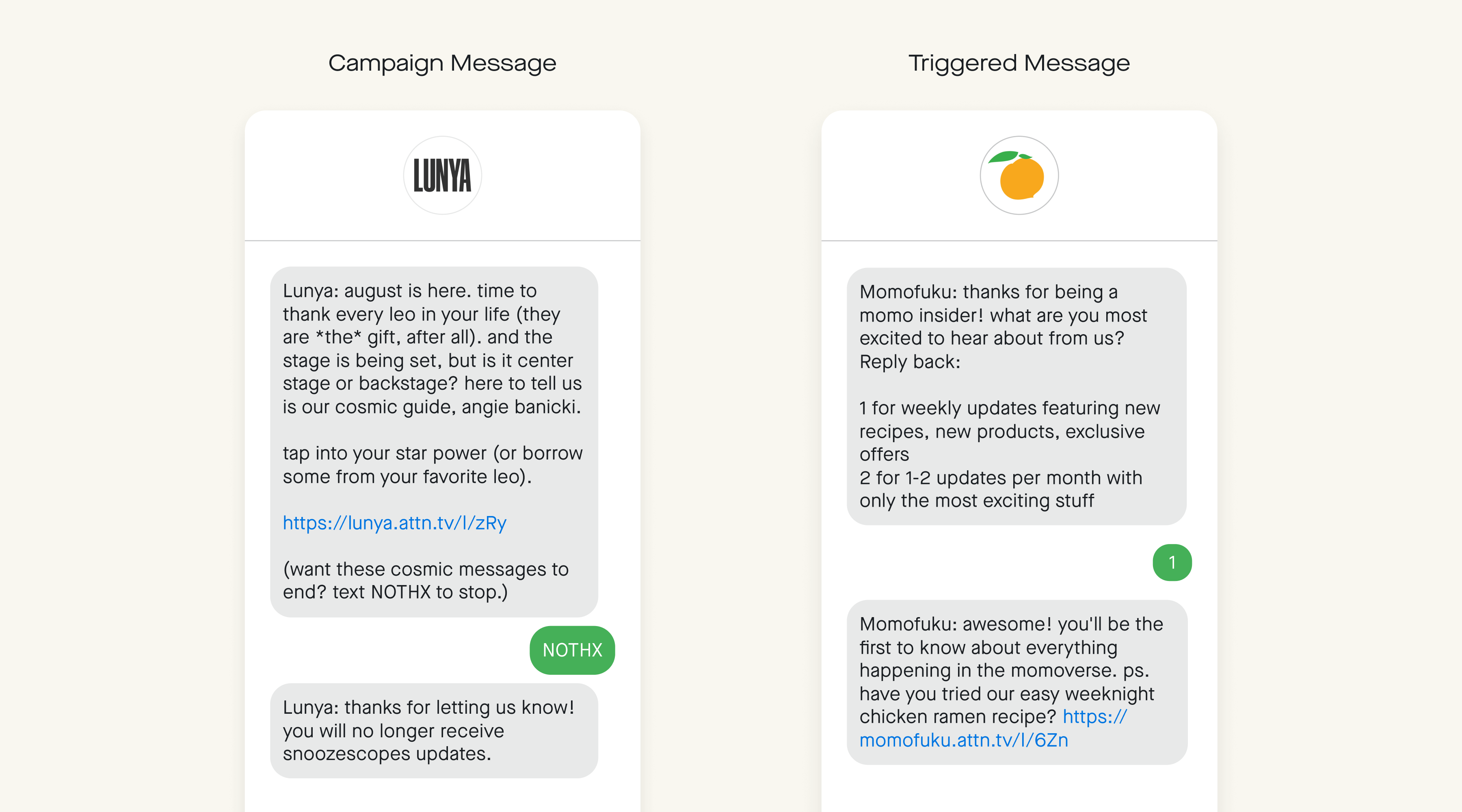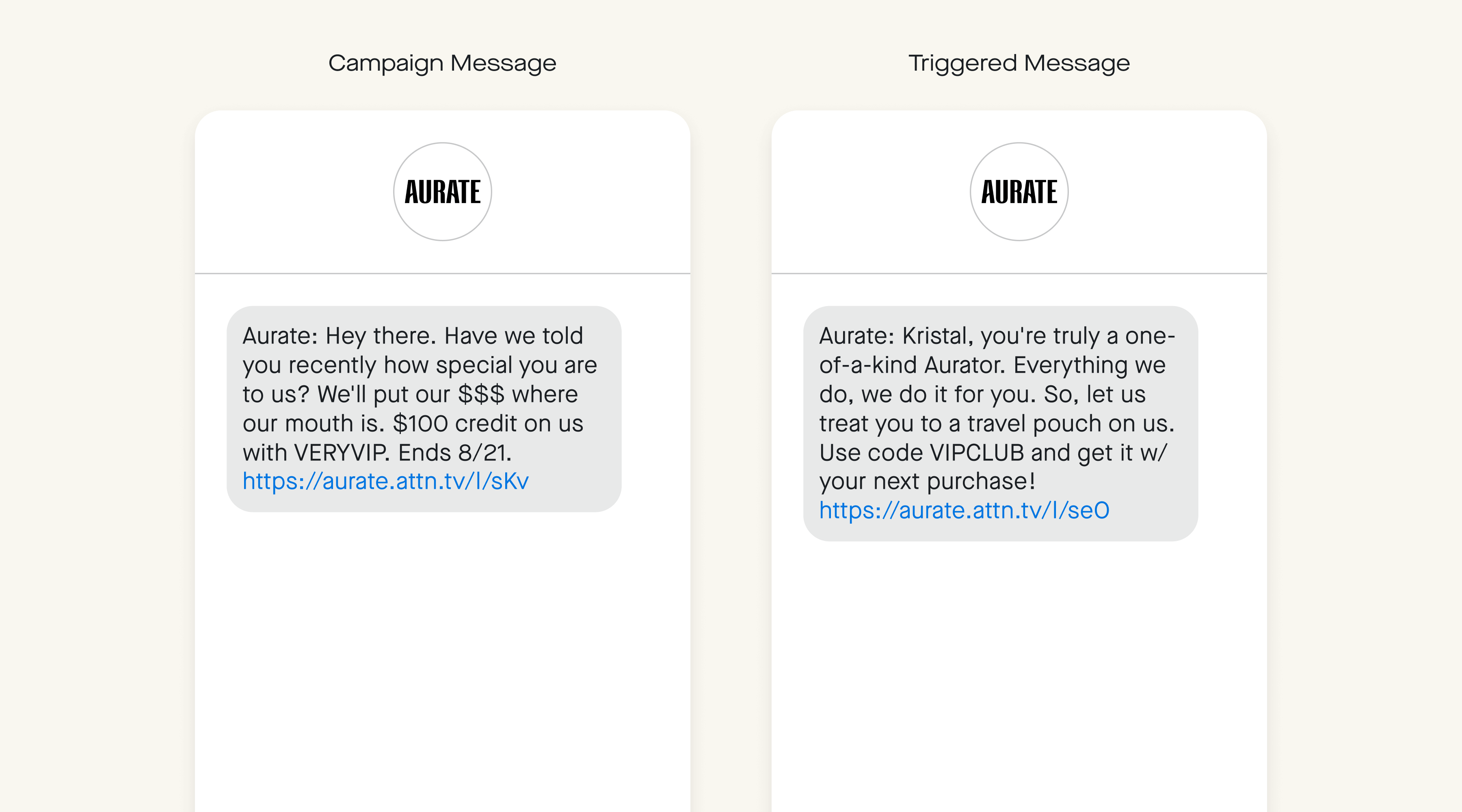
New releases
A smarter, simpler Attentive
Explore new features →
Explore new features →

Your SMS program is up and running, and you’re ready to start sending text messages that engage your subscribers and inspire them to convert. But if you’re not sure what types of texts you should be sending to achieve your goals, you’re not alone. In fact, this is one of the most common questions we get asked about SMS marketing.
The short answer is that, no matter what you’re trying to accomplish, you’ll want to focus on sending a mix of one-time campaign text messages and triggered messages (also known as journeys).
Keep reading for a breakdown of what makes campaigns and triggered messages unique, best practices to follow for each, and strategies for using both to reach your specific goals.
Most brands focus on sending these two main types of messages to keep subscribers engaged at every possible touchpoint. So what’s the difference between a campaign text message and a triggered text message? And what are the benefits of each?
Campaigns are one-time messages that you can send on-demand, or schedule in advance based on your marketing content calendar, to create a sense of urgency and drive revenue in real time.
They're ideal for promoting time-sensitive offers that you want subscribers to act on immediately. But you can also tailor them to engage your subscribers around non-promotional moments, build brand awareness, and increase retention.
Think about creating and sending campaigns around these three content buckets:
You can send campaign text messages to your entire SMS list, or you can incorporate segmentation to target specific customer groups within your subscriber base and boost message performance. Either way, regularly sending these kinds of messages is an effective way to make sure your brand stays top of mind with some of your most loyal shoppers.
Also known as journeys, triggered text messages help you drive ongoing engagement and loyalty by sending personalized messages at critical points in the customer lifecycle. They trigger based on specific behaviors or actions your subscribers take and include:
Compared to single-send campaigns, these journeys are always on, allowing you to automate key conversion opportunities. Once you set them up, they continue to work for your brand and build cumulative revenue in the background.
It’s worth noting that you can also incorporate Two-Way Journeys into your campaign messages, prompting subscribers to reply with the first keyword, to learn about their individual preferences or to deliver personalized product recommendations.
Whether you’re just starting to send text messages or you’re looking for ways to improve your current messaging strategy, follow these best practices to create campaigns and journeys that are effective and engaging.
SMS is an immediate marketing channel, but it’s also a personal one, so it’s important to write and send text messages that are easy to read with a clear call to action.
For both campaigns and journeys messages, we recommend keeping your copy between 75-115 characters, or 3-4 lines long. Also think about how you can use timely language and create a sense of urgency for your subscribers to act—whether it's taking advantage of a flash sale that’s happening for “one day only,” or returning to their shopping cart to complete their order “before it’s gone.”
In general, we recommend sending around eight campaign text messages per month to maximize your revenue per send. But we also know that every brand’s customer base is different. While many consumers are open to hearing from brands multiple times per week, others may prefer to get marketing text messages less frequently.
Experiment with when and how often you send campaign messages to find the ideal cadence for your SMS audience. Evaluate how your subscribers respond by looking at click, conversion, and opt-out rates. You can also use your welcome series to ask new subscribers how often they want to hear from you, and use keywords to save their cadence preferences as custom attributes.
The key is to be consistent so your subscribers know what to expect whenever they get a text from your brand. That can mean sending a certain number of messages per week, on the same days every week, or creating a content schedule that includes a special offer or discount on the last Friday of every month.
Since messages in journeys are triggered based on specific subscriber behaviors, you want to focus on using them to increase the likelihood of conversion at key touchpoints. Think about where you want to have the most influence along the customer journey, and how you can incorporate triggered messaging to help achieve that goal.
For example, if people are visiting your site but not converting, you can create a browse abandonment journey to re-engage those shoppers and encourage them to come back and shop. Or, if your goal is to drive more repeat purchases, you can send recent shoppers a post-purchase message with related product recommendations. These kinds of triggered messages are essential for scaling your marketing efforts.
A/B testing helps you understand what resonates with your subscribers, what doesn’t work as well, and where you can make tweaks to improve your overall strategy. You can experiment with a lot of different elements in your campaigns and journeys to figure out what works best for each:
Pro tip: We recommend only testing one variable at a time to get the most accurate results. For example, if you want to test SMS vs. MMS and compare the performance of using a casual vs. a professional tone, you should run two separate A/B tests, rather than testing both variables at the same time.
Even when you find something that works, you should continue to test your campaigns and journeys regularly to make sure you’re always sending the most effective messages possible.
Once you’ve established an ideal frequency for texting your entire SMS list, and you’ve run some A/B tests to understand what performs best, it’s a good idea to start segmenting your audience. Personalized text messages, tailored to your subscribers' specific interests and behaviors, are more likely to inspire action (like clicking through and making a purchase).
Here are some examples of dynamic audience segments you can create:
You can also bring segmentation into your triggered messaging strategy with Magical Journeys, which trigger when a subscriber enters into a specific segment (that you choose) for the first time. For example, after someone makes multiple purchases, you can add them to a VIP segment and send them a message with a special reward. Or, you can add someone to a “lapsed” or “unengaged” segment when they haven't purchased in a while and trigger a message offering them a discount to come back and shop.
Depending on the goals you've set for your brand's SMS channel, you can—and should—use both campaigns and triggered messages in unique ways to achieve them. Here are some ideas and strategies to help you get started.
Share non-promotional content (i.e., not a discount or sale) that helps your subscribers learn more about your brand and products. Think about how you can weave your mission and values into the customer journey and show your audience what or who they’re supporting by buying from your brand.

Campaign strategy
Send messages periodically that bring your subscribers behind the scenes. For example, if your brand is committed to sustainability, you can highlight your production process when promoting specific products or items (like the materials you use to make them and why). Or, you can talk about your factories and supply chain and link out to blog posts or other helpful resources.
Triggered strategy
Take the same content ideas from your brand marketing SMS campaigns and incorporate them into your triggered journeys. Use your welcome message to introduce new subscribers to your core values and thank them for supporting your mission. Or, use your cart abandonment reminder to let subscribers know that when they make a purchase, they’re also donating to a good cause.
Start a two-way conversation with your subscribers and ask them about their content and shopping preferences. Once you know what someone’s interested in, you can send them more relevant and personalized text messages that they want to engage with.

Campaign strategy
Send a campaign message that invites subscribers to reply with the first keyword in a conversational journey. You can create gamified experiences like scavenger hunts or guessing games, or ask questions that lead to personalized product recommendations. But you can also use keywords to let subscribers opt out of certain messages that don’t meet their needs or align with their interests.
Triggered strategy
Get to know new subscribers as soon as they opt in to SMS by using Two-Way Journeys in your welcome series to learn about their product preferences. By saving their replies as custom attributes, you'll collect valuable zero-party data that you can use to create dynamic segments and increase personalization.
Each time a subscriber makes a purchase, you learn something new about the products they like or how often they shop. You can use those insights to keep them engaged long-term and inspire them to make another purchase in the future (increasing their customer lifetime value).

Campaign strategy
Create a dynamic segment of subscribers who’ve purchased specific products (like anything from your lip product category) to let them know when similar items are on sale. Or, send these customers a targeted campaign when you're launching a product that complements their previous purchases.
Triggered strategy
Set up a triggered post-purchase journey that encourages recent shoppers to keep engaging with your brand in some way. Send them specific care instructions or product usage tips. Recommend complementary products or collections. Invite them to leave a review or join your loyalty program. The key is to make sure your brand stays top of mind until they’re ready to make another purchase.
We recommend giving these customers at least one week to use and enjoy the item they purchased before following up.
Use your SMS channel to nurture happy, returning customers and reward them for being loyal shoppers. Think about how you can give them the VIP treatment, so they want to keep coming back to your brand—and refer their friends to buy from you, too.

Campaign strategy
Send campaigns to a VIP segment of subscribers who've spent a certain amount with your brand since signing up for texts. You can offer them special perks to show that you value their loyalty, like a free gift or a credit to use on their next purchase.
Triggered strategy
Create a Magical Journey that automatically rewards shoppers when they reach VIP status, like hitting a specific lifetime spend threshold or making multiple purchases in a given time frame.
During the holiday season, consumers are ready and waiting for some of the best sales they’ll get access to all year. Tap into your audience of SMS subscribers and send them timely messages when your sales drop (or when time’s running out for them to take advantage of those deals).

Campaign strategy
Let your SMS subscribers know about your Black Friday and Cyber Week sales first, and give them early access to shop before anyone else. Send text reminders throughout the week, and use segmentation to exclude any subscribers who’ve already made a purchase, so you’re only targeting those who haven’t converted yet.
Triggered strategy
Add timely language to your browse and abandoned cart reminders to create a sense of urgency with high-intent shoppers and encourage them to shop your best deal of the year while it's still going on.
Sometimes an item is so popular that it sells out before a customer can buy it. While this can be a disappointing moment for a shopper, there’s an upside for your brand. When that product comes back in stock, you have a natural opportunity to reach re-engage your audience and let them know via text.

Campaign strategy
Create excitement around back-in-stock products by sending a campaign message when your most coveted items or best sellers are available for purchase again. You can send it to your entire SMS list, or you can use segmentation to target all subscribers who’ve viewed that specific product recently and encourage them to buy it before it sells out again.
Triggered strategy
Set up a triggered back-in-stock journey to alert individual subscribers when an out of stock item they viewed comes back in stock. Doing this allows you to automate the process of reminding them that they had their eye on something in particular, so you can get them to come back, make a purchase, and recover the otherwise lost revenue.
Want to level up your SMS program even more? Explore our resources to discover strategies and tactics to add your text messaging toolkit.